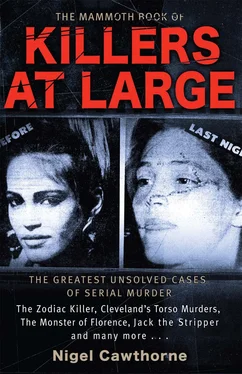Lee was found guilty of the second-degree murder of Geralyn DeSoto on 10 August 2004, after his 15-year-old son testified to seeing his father’s bloody boots. The verdict brought a mandatory life sentence. On 12 October, Lee was found guilty of the first-degree murder of Charlotte Murray Pace after the prosecution was allowed to introduce evidence from other suspected Baton Rouge serial killer cases to prove a pattern. He was sentenced to death. As he was taken from the courtroom he shouted: “God don’t sleep.” Then he cried: “They don’t want to tell you about the DNA they took eight times.”
While he has been found guilty in these two case, he has not been prosecuted in any of the others. No one has explained the discrepancies between Derrick Todd Lee and the serial-killer profile—or even the early evidence. So there could be a white male serial killer with a white pick-up still out there.
Charlotte, N.C.’s Killers
On 4 October 1996, the people of Charlotte, North Carolina were told that the police suspected a serial killer was at work and was possibly responsible for the murder of at least four African-American women since 1992. They speedily set up a task force to investigate the unsolved cases.
The authorities moved with such despatch in this case because of public reaction to their recent investigation of the murders committed by Henry Louis Wallace. Arrested in March 1994, after killing four in three weeks, Wallace admitted to murdering ten African-American women in Charlotte in a 22-month period.
Charlotte police were severely criticized for not making an arrest sooner. Initially they had not even admitted that a serial killer was at large. Black residents were particularly scathing, saying the police should have spotted similarities between the slayings. All the victims were attractive young black women who had been strangled, usually after being raped, in their own home. The police denied the allegation of racism, saying that Wallace, who is also black, did not fit the general profile of a serial killer. Unusually Wallace preyed on acquaintances, friends of his sister or former girlfriend, or colleagues in the fast-food restaurants where he worked. This is rare. Serial killers usually murder strangers.
Wallace was also outgoing and charming, not the archetypal brooding loner. He also varied his MO. Some victims were stabbed. In one case, he poured rum on one victim’s body and set fire to her apartment to obscure the cause of death. Before he left the murder scenes, Wallace wiped off fingerprints and washed his victims. However, he could be slovenly. He would put incriminating articles in the stove to burn them, then forget to turn the stove on. He returned to the apartment of his final victim, Debra Slaughter, to smoke crack after he had strangled her and stabbed her 38 times. Then he put on her Chicago White Sox jacket, grabbed a beer from her refrigerator and left.
Of his killings he said: “It was like an out-of-body experience. It was like I didn’t want to, but something or somebody was taking over my body, and I couldn’t even stop when I tried to stop.”
Despite being a confessed serial killer Henry Louis Wallace got married before he died. The ceremony took place on 5 June 1998 in a room next to the execution chamber where he was sentenced to die. The bride Rebecca Torrijas, a former prison nurse, wore a pale green dress covered with pink flowers and a pearl necklace; the groom a red prison jumpsuit and black tennis shoes. Wallace’s court-appointed attorney, Mecklenburg County public defender Isabel Day, served as the witness and photographer. Also present was the manager of death row. The newlyweds were allowed to talk for some 20 minutes in the room where they were married. Then they were allowed another hour in a room separated by plastic glass and bars.
Despite the speed with which the police set up a task force to catch the new killer in 1996, they made little progress and a second task force was established in April 1999, when a fifth African-American woman was added to the list of victims. Like the others, she had been a drug user and prostitute.
On 14 May Charlotte police charged 58-year-old converted Muslim Jafar Abdul Talib, formerly known as Willie James Lynch, with one of the killings. He had already been in the Mecklenburg County Jail on an unrelated charge of assault with a deadly weapon with intent to kill. He had previously been charged with the murder of a woman in 1985. But that charge was later dismissed by the district attorney’s office. However, police say they have not ruled out the possibility that the other women were the victims of an as yet unidentified serial killer.
Chicago’s Crack-Head Killers
On 22 July 1999, the authorities in Chicago issued a city-wide warning confirming that some four separate sex killers were active in the city who were responsible for the murder of as many as twelve African-American prostitutes in and around the city’s South Side over the previous four years. The murders centred on Englewood, between 51st and 59th Streets, and Halsted and Damen—an area ravaged by heroin and crack cocaine. The police said that the victims all lived the same “high-risk” lifestyle, selling sex to buy drugs.
Police Commander Frank Briggs of the Chicago PD said: “We are now dealing with four distinct patterns. We have four individuals involved in 11 homicides and in two criminal sexual assaults.”
DNA samples collected from the victims linked one man to seven murders, another one to three, and two more men to one murder and two rapes. Many of the dead were found in burnt-out buildings in Englewood and the adjoining New City Area, and in Washington Park. The police believed that the killers picked out the locations during the daylight hours, then at night picked out their victims, lured them back there with drugs, then raped and murdered them.
By then, the police had already arrested two men in connection with the multiple murder of women in Englewood and New City neighbourhoods. However, the killings continued.
On 12 November 1997 Hubert Geralds Jnr, of 5601 South May Street, was found guilty of killing six women in Englewood in 1994 and 1995, along with one count of rape and attempted murder. The verdict came after an eight-day trial and some 12 hours of deliberation. All seven attacks occurred within a 15-block area over a six-month period.
Along with DNA evidence that linked Geralds to the rape of at least four of the victims, damning testimony came from 27-year-old Cleshawn Hopes, who tearfully described how she narrowly escaped becoming Gerald’s seventh victim.
Hopes said she had been smoking crack cocaine with Geralds in her apartment before the attack. The two went out to buy more drugs, but parted company to make their score separately. As she walked by an alley near the intersection of 57th Street and Racine Avenue, she was grabbed from behind. Picked up off the ground in a chokehold, she passed out. When she came around she was in a wrecked van with Geralds on top of her, she said. A quick-thinking girl, she managed to convince him that he “could get it for free”. When he relented, she made her escape, running from the van naked from the waist down. Prosecutors maintained that Geralds had taken drugs with all of the dead women. They also said that DNA evidence linked him to a seventh slaying.
The defence contended that Geralds was mentally retarded, with the brain of an eight-year-old and had a sexual deviation that compelled him to have sex with women while they were asleep or unconscious. Geralds had become obsessed after watching a film, during which a man strangled a woman during sex, while he was in prison on drug charges, and vowed to do the same when he was released.
The prosecution dismissed Geralds as “a fake” and brought witnesses to testify that, although Geralds had impaired intellectual functioning, this did not affect his ability to tell right from wrong. The jury recommended that he be sentenced to death by lethal injection. Two months later a judge confirmed the sentence.
Читать дальше











